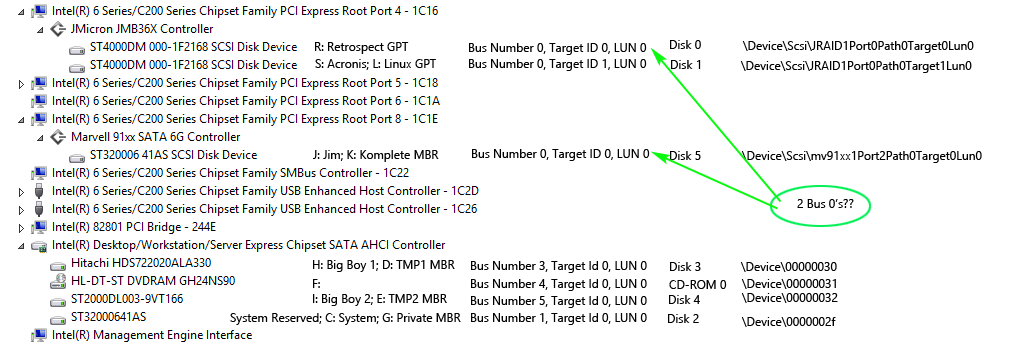

- Messages
- 282
- Location
- Sunnyvale, CA USA
If you look at drive properties in the device manager, there is a 'Details' tab with a property called "Location information". It specifies Bus Number, Target ID, and LUN for the hard drive.
I have several drives and I was curious about the physical properties so I made a little diagram starting from the Device manager and cutting and pasting various other infos.
I was curious to see that I had two 'Bus Number 0' in my system - One for the JMicron drive port and one for the Marvell drive port.
Is this normal?
The picture below shows drive name, volumes on it and format type, Bus name, Disk number, and physical device object name:

I have several drives and I was curious about the physical properties so I made a little diagram starting from the Device manager and cutting and pasting various other infos.
I was curious to see that I had two 'Bus Number 0' in my system - One for the JMicron drive port and one for the Marvell drive port.
Is this normal?
The picture below shows drive name, volumes on it and format type, Bus name, Disk number, and physical device object name:

My Computer
System One
-
- OS
- Windows 8.1 Pro with Media Center (64-bit)
- Computer type
- PC/Desktop
- System Manufacturer/Model
- Custom-build
- CPU
- Intel Core i7-2600K @ 4.3 GHz
- Motherboard
- ASUS P8P67 PRO Rev 3.0
- Memory
- 16 GB G.SKILL Ripjaws X DDR3 SDRAM DDR3 1600 (4 banks 4GB DIMM DDR3 8-8-8-24 5-32-12-7 1T 1.5V)
- Graphics Card(s)
- NVIDIA GeForce GT 440
- Sound Card
- Firewire Focusrite Saffire Pro 14
- Monitor(s) Displays
- LG W2353V
- Screen Resolution
- 1920x1080
- Hard Drives
- 2 of Seagate Barracuda XT ST32000641AS (2TB ea.);
1 of Seagate Barracuda Green ST2000DL003 (2TB);
1 of Hitachi Deskstar HDS722020ALA330 (2TB);
2 of Seagate Desktop ST4000DM000-1F2168 (4TB)
- PSU
- Corsair AX850 Gold
- Case
- Cooler Master HAF 932 Advanced
- Cooling
- ThermalTake Silent 1156
- Keyboard
- Logitech K520
- Mouse
- Logitech M310
- Internet Speed
- 7Mbps
- Browser
- Chrome
- Antivirus
- Kaspersky
- Other Info
- Event Studio Precision 6 powered audio monitors;
Boston Acoustics CS Sub 10 Powered Subwoofer;
NI Kore controller;
NI Maschine controller;
M-Audio Axiom 61 keyboard controller; expression pedal; sustain pedal;
... and tons of audio software ...
I also keep two USB 3 thumb drives (A: and B:) attached with boot recovery and security stuff that I can boot into from BIOS in case of emergency
